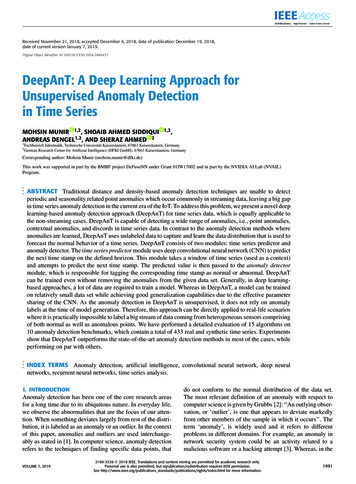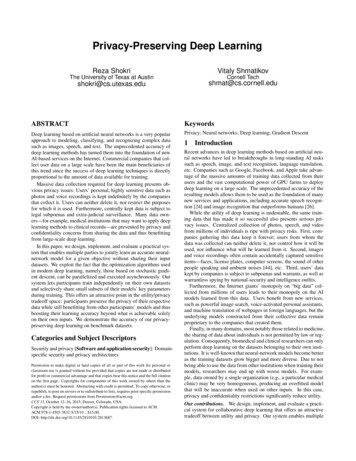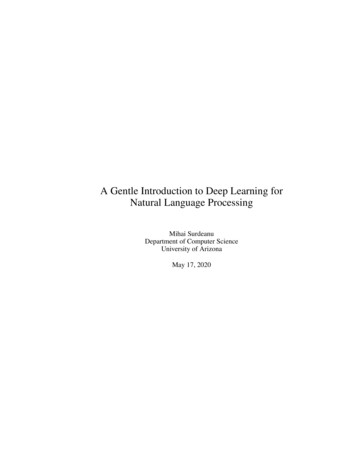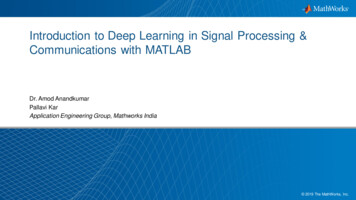
Transcription
Received November 21, 2018, accepted December 4, 2018, date of publication December 19, 2018,date of current version January 7, 2019.Digital Object Identifier 10.1109/ACCESS.2018.2886457DeepAnT: A Deep Learning Approach forUnsupervised Anomaly Detectionin Time SeriesMOHSIN MUNIR 1,2 , SHOAIB AHMED SIDDIQUIANDREAS DENGEL1,2 , AND SHERAZ AHMED 21,2 ,1 Fachbereich2 GermanInformatik, Technische Universität Kaiserslautern, 67663 Kaiserslautern, GermanyResearch Center for Artificial Intelligence (DFKI GmbH), 67663 Kaiserslautern, GermanyCorresponding author: Mohsin Munir (mohsin.munir@dfki.de)This work was supported in part by the BMBF project DeFuseNN under Grant 01IW17002 and in part by the NVIDIA AI Lab (NVAIL)Program.ABSTRACT Traditional distance and density-based anomaly detection techniques are unable to detectperiodic and seasonality related point anomalies which occur commonly in streaming data, leaving a big gapin time series anomaly detection in the current era of the IoT. To address this problem, we present a novel deeplearning-based anomaly detection approach (DeepAnT) for time series data, which is equally applicable tothe non-streaming cases. DeepAnT is capable of detecting a wide range of anomalies, i.e., point anomalies,contextual anomalies, and discords in time series data. In contrast to the anomaly detection methods whereanomalies are learned, DeepAnT uses unlabeled data to capture and learn the data distribution that is used toforecast the normal behavior of a time series. DeepAnT consists of two modules: time series predictor andanomaly detector. The time series predictor module uses deep convolutional neural network (CNN) to predictthe next time stamp on the defined horizon. This module takes a window of time series (used as a context)and attempts to predict the next time stamp. The predicted value is then passed to the anomaly detectormodule, which is responsible for tagging the corresponding time stamp as normal or abnormal. DeepAnTcan be trained even without removing the anomalies from the given data set. Generally, in deep learningbased approaches, a lot of data are required to train a model. Whereas in DeepAnT, a model can be trainedon relatively small data set while achieving good generalization capabilities due to the effective parametersharing of the CNN. As the anomaly detection in DeepAnT is unsupervised, it does not rely on anomalylabels at the time of model generation. Therefore, this approach can be directly applied to real-life scenarioswhere it is practically impossible to label a big stream of data coming from heterogeneous sensors comprisingof both normal as well as anomalous points. We have performed a detailed evaluation of 15 algorithms on10 anomaly detection benchmarks, which contain a total of 433 real and synthetic time series. Experimentsshow that DeepAnT outperforms the state-of-the-art anomaly detection methods in most of the cases, whileperforming on par with others.INDEX TERMS Anomaly detection, artificial intelligence, convolutional neural network, deep neuralnetworks, recurrent neural networks, time series analysis.I. INTRODUCTIONAnomaly detection has been one of the core research areasfor a long time due to its ubiquitous nature. In everyday life,we observe the abnormalities that are the focus of our attention. When something deviates largely from rest of the distribution, it is labeled as an anomaly or an outlier. In the contextof this paper, anomalies and outliers are used interchangeably as stated in [1]. In computer science, anomaly detectionrefers to the techniques of finding specific data points, thatVOLUME 7, 2019do not conform to the normal distribution of the data set.The most relevant definition of an anomaly with respect tocomputer science is given by Grubbs [2]: ‘‘An outlying observation, or ‘outlier’, is one that appears to deviate markedlyfrom other members of the sample in which it occurs’’. Theterm ‘anomaly’, is widely used and it refers to differentproblems in different domains. For example, an anomaly innetwork security system could be an activity related to amalicious software or a hacking attempt [3]. Whereas, in the2169-3536 2018 IEEE. Translations and content mining are permitted for academic research only.Personal use is also permitted, but republication/redistribution requires IEEE permission.See http://www.ieee.org/publications standards/publications/rights/index.html for more information.1991
M. Munir et al.: DeepAnT: Deep Learning Approach for Unsupervised Anomaly Detection in Time Seriesmanufacturing domain a faulty product is considered as ananomaly. It is very important to detect anomalies as early aspossible to avoid big issues like financial system hack, totalmachine failure, or a cancerous tumor in human body.Companies from different sectors including manufacturing, automotive, healthcare, lodging, traveling, fashion, food,and logistics are investing a lot of resources [4], [5] in collecting big data and exploring the hidden anomalous patternsin them to facilitate their customers. In most of the cases,the collected data are streaming time series data and due totheir intrinsic characteristics of periodicity, trend, seasonality,and irregularity, it is a challenging problem to detect pointanomalies precisely in them. Furthermore, in most of reallife scenarios, it is practically impossible to label enormousamount of data, therefore, we are using an unsupervisedmethod. Although many unsupervised methods are available, they don’t handle the intrinsic characteristics of timeseries data. For example, traditional distance based anomalydetection techniques do not incorporate context of a timeseries, due to which they are unable to find point anomaliesoccurring in cycles. The proposed unsupervised approachincorporates context, seasonality, and trend into account fordetecting anomalies. This approach can be adapted for different scenarios and use cases, and works on data from differentdomains.This paper presents DeepAnT, a novel unsupervised deeplearning based anomaly detection approach for streamingdata. This approach doesn’t rely on labeling of anomaliesrather it leverages the original time series data even withoutremoving anomalies (given that the number of anomalies inthe data set is less than 5% [3]). DeepAnT employs CNNas its forecasting module. This module predicts the nexttime stamp of a given time series window. Subsequently,the forecasted value is passed to a detector module, whichcompares that value with the actual data point to detectanomalies in real-time. The approach is realistic and suitableeven for domains where time series data are collected fromheterogeneous sources and sensors. DeepAnT achieves goodgeneralization capabilities in data scarce scenarios where lesstraining data are available. Only a few number of trainingsamples (depending on the data set, e.g. 568 data points fromYahoo data set and 140 data points from Ionosphere data set)are sufficient to build a prediction model due to its effectiveparameter sharing during feature extraction. DeepAnT whentested on publicly available anomaly detection benchmarks,outperformed the state-of-the-art anomaly detection methods in most of the cases. Instead of classifying whole timeseries as normal or abnormal (as done in [6]–[9]), DeepAnT’sobjective is to robustly detect point anomalies. In particular,following are the main contributions of this paper:1) To the best of our knowledge, DeepAnT is the first deeplearning based approach which is capable of detectingpoint anomalies, contextual anomalies, and discords intime series data in an unsupervised setting.2) The proposed pipeline is flexible and can be easilyadapted for different use cases and domains. It can1992be applied to uni-variant as well as multi-variant timeseries.3) In contrast to the LSTM based approach, CNN basedDeepAnT is not data hungry. It is equally applicable tobig data as well as small data. We are only using 40% ofa given time series to train a model.4) We gathered different anomaly detection benchmarks atone place and provided extensive evaluation of 15 stateof-the-art methods in different settings on 10 datasets (covering both steaming and non-streaming cases)which contain 433 time series in total. DeepAnT hasgained the state-of-the-art performance on most of thedata sets.The rest of the paper is organized as follows. Section II provides an overview of existing methods for anomaly detection.The state-of-the-art anomaly detection methods are mentioned and summarized in Section III, which are evaluatedand compared with the proposed technique in Section V.Section IV provides details about the presented approach foranomaly detection in time series data. Section V provides adetailed evaluation of the DeepAnT along with a solid comparison with other state-of-the-art anomaly detection methods on different benchmarks. This section is further dividedinto sub-sections which elaborates on the details of the useddata sets and the experimental settings of the state-of-theart methods. Finally, Section VI concludes the paper andsketches direction for possible future work.II. LITERATURE REVIEW OF ANOMALYDETECTION METHODSDue to the large variety of scenarios and algorithms,anomaly detection problem is categorized in many ways.The most common categorization is based on the level ofsupervision required by the algorithm; supervised, semisupervised, and unsupervised. Another categorization, followed by Aggarwal [10], is based on the underlying usedmethods. Examples of such methods for outlier detection areprobabilistic models, statistical models, linear models, proximity based models, and outlier detection in high dimensions.In addition, anomaly detection methods also exist based ondifferent machine learning and deep learning techniques.In this section, an overview of commonly used anomalydetection techniques is provided. First, we talk about anomalydetection techniques which are widely used for point anomalies. Then, an overview of anomaly detection techniquesdesigned for time series data is given. In the end, anomalydetection techniques based on deep neural networks arediscussed.Statistical anomaly detection techniques are most commonly employed to detect anomalies. k-NN anomalydetection method is the simplest and most widely used unsupervised global anomaly detection method for point anomalies. This distance based algorithm calculates the anomalyscore based on k-nearest-neighbors distance [11]. This technique is computationally expensive, highly dependent on thevalue of k, and may fail if normal data points do not haveVOLUME 7, 2019
M. Munir et al.: DeepAnT: Deep Learning Approach for Unsupervised Anomaly Detection in Time Seriesenough neighbors. Breunig et al. [12] presented the mostwidely used unsupervised method for local density-basedanomaly detection known as Local Outlier Factor (LOF).In LOF, k-nearest-neighbors set is determined for eachinstance by computing the distances to all other instances.The basic assumption of this algorithm is that the neighbors ofthe data instances are distributed in a spherical manner. However, in some application scenarios, where normal data pointsare distributed in a linearly connected way, the spherical estimation of density becomes inappropriate [3]. Tang et al. [13]proposed an improved version of LOF known as Connectivitybased Outlier Factor (COF), which improves the linear structure taken into account. A shortcoming of this algorithm isincorrect outlier score estimation in some cases when clusterswith different densities are very close to each other. In suchcases, instances at the border of the low-density clusters arelocal outliers with respect to the high density clusters [3].This shortcoming is further resolved in Influenced Outlierness (INFLO) [14] algorithm.Other than nearest neighbor based algorithms, clusteringbased algorithms are also used for unsupervised outlier detection. As name suggests, Cluster-Based Local Outlier Factor (CBLOF) [15] is a clustering based anomaly detectionalgorithm, in which data points are clustered using k-means(or any other) clustering algorithm. The anomaly score ofan instance is the distance to the next large cluster. As thisapproach is based on clustering algorithm, the problem ofchoosing the right number of clusters arises, and reproductionof the same anomaly score also becomes impossible due tonon-deterministic nature of clustering algorithms.Histogram-Based Outlier Score (HBOS) [16] is anotherstatistical unsupervised anomaly detection algorithm. Thisalgorithm is computationally far less expensive as comparedto nearest neighbor and clustering based anomaly detectionmethods. HBOS works on arbitrary data by offering a standard fixed bin width histogram as well as dynamic bin width(fixed amount of items in each bin).Semi-supervised and unsupervised variants of anomalydetection algorithms exist based on One-Class Support Vector Machine (OCSVM). Unsupervised variant of OCSVMwas introduced by Amer et al. [17]. Based on the ideaof [18], no prior training data are required for this technique.It attempts to learn a decision boundary that achieves the maximum separation between the points and the origin. This technique is also used for detecting anomalies in activities of dailylife for example sleeping, sitting, and walking patterns [19].Another time series anomaly detection technique based onOCSVM was proposed by Hu et al. [20]. In this technique, sixmeta-features on actual univariate or multivariant time seriesare defined first and then OCSVM is applied on meta-featurebased data space to find abnormal states. In general, OCSVMis sensitive to the outliers when there are no labels. It is alsoused as a novelty detection technique. Liu et al. [21] proposedan approach to detect outliers based on Support Vector DataDescription (SVDD) [22].VOLUME 7, 2019Shyu et al. [23] proposed an approach for anomalydetection based on Principle Component Analysis (PCA),where predictive model is constructed from the majorand minor principle components of the normal instances.Kwitt and Hofmann [24] proposed another variation ofthis technique, in which Minimum Covariance Determinant (MCD) is used for calculation of covariance andcorrelation matrix instead of standard estimators.To incorporate time series characteristics, there exist different anomaly detection techniques which are designed tofind anomalies specifically for streaming time series data.Netflix open-sourced it’s anomaly detection function calledRobust Anomaly Detection (RAD) in 2015 [25]. The functionis based on Robust Principle Component Analysis (RPCA)to detect anomalies. To detect anomalous time series inmulti-terabyte data set, a disk aware algorithm is proposedin [26]. Statistical autoregressive-moving-average (ARMA)model and its variations such as ARIMA and ARMAX areused widely for time series prediction and anomaly detection. Yu et al. [27] presented an anomaly detection technique for traffic control in wireless sensor networks, whichis based on ARIMA model. They proposed that short stepexponential weighted average method is the key to makebetter anomaly detection judgment in the network traffic.In the same domain, Yaacob et al. [28] proposed a techniquefor early warnings detection of Denial-of-Service (DoS)attacks. By comparing actual network traffic with the predicted patterns generated by ARIMA, anomalous behaviorsare identified.Nowadays, Artificial Neural Networks (ANN) have beensuccessfully employed in a wide range of domains, such ashand writing recognition, speech recognition, document analysis, activity recognition, and many more; mainly for classification and prediction purposes. Different ANN architectureshave been successfully leveraged for time series analysis. Theanomaly detection technique proposed by Malhotra et al. [6]is based on stacked LSTMs. Their predictive model is trainedon normal time stamps, which is further used to compute errorvectors for given sequences. Based on the error threshold,a time series sequence is marked as normal or anomalous.Chauhan and Vig [8] used similar approach to detect anomalies in ECG data. They used RNN, augmented with LSTM,to detect 4 different types of anomalies. Another deep learning based anomaly detection technique was recently proposedby Kanarachos et al. [29], in which they combine waveletand Hilbert transform with deep neural networks. They aimto detect anomalies in time series patterns.Lipton et al. [7] used LSTM to classify a time series asnormal or abnormal. They applied their technique on a clinical data set and demonstrated that LSTM trained on onlyraw time series with target replication outperforms MLPtrained on hand engineered features. Zheng et al. [30] usedCNN for multivariate time series classification. They proposed Multi-Channel Deep CNN (MC-DCNN) where eachchannel takes a single dimension of multivariate time series1993
M. Munir et al.: DeepAnT: Deep Learning Approach for Unsupervised Anomaly Detection in Time Seriesdata as input and learns the features individually. This isfollowed by a layer of MLP to perform classification. Experimental results show that MC-DCNN outperforms competingbaseline methods which are K -nearest neighbor (based onEuclidean Distance and Dynamic Time Wrapping). All ofthe aforementioned deep learning based time series anomalydetection techniques are used for classifying a sequence or asubsequence as normal or abnormal.Autoencoder is a type of neural network which istrained to reproduce its input. Typically, autoencoders areused for dimensionality reduction which helps in classification and visualization tasks. Due to its efficient dataencoding in an unsupervised manner, it is also gainingpopularity for anomaly and novelty detection problems.Amarbayasgalan et al. [31] proposed a novelty detectiontechnique based on deep autoencoders. Their approach getscompressed data and error threshold from deep autoencodersand apply density-based clustering on the compressed datato get novelty groups with low density. Schreyer et al. [32]also used deep autoencoders to detect anomalies in largescale accounting data in the area of fraud detection.III. THE STATE-OF-THE-ART METHODSUSED FOR COMPARISONThis section summarizes the state-of-the-art methods used forcomparison with the proposed approach. Twitter Inc. opensourced it’s anomaly detection1 package in 2015, which isbased on Seasonal Hybrid ESD (S-H-ESD) algorithm [33].This technique is based on Generalized Extreme StudentizedDeviate (ESD) test [34] to handle more than one outliers, andSeasonal and Trend Decomposition using Loess (STL) [35]to deal with the decomposition of time series data and seasonality trends. Twitter Anomaly Detection can detect bothglobal and local anomalies. They have provided two anomalydetection functions for detecting anomalies in seasonalunivariate time series:(i) AnomalyDetectionTS function is used when input is aseries of timestamp, value pairs.(ii) AnomalyDetectionVec function is used when input is aseries of observations.Another anomaly detection method, EGADS [36], whichdetects anomalies in large scale time series data was releasedby Yahoo Labs.2 EGADS (Extensible Generic AnomalyDetection System) consists of two main components: Timeseries Modeling Module (TMM) and Anomaly DetectionModule (ADM). For a given time series, TMM models thetime series and produces an expected value at time stamp t.ADM compares the expected value with the actual value andcomputes number of errors E. Automatic threshold is determined on E and most probable anomalies are given as output.There are seven time series models which are supported byTMM and three anomaly detection models.1 Source code of Twitter Anomaly Detection: es2 EGADS Java Library: https://github.com/yahoo/egads1994ContextOSE [37] is based on Contextual Anomaly Detection (CAD) method. As name indicates, CAD is based onthe contextual/local information of time series instead ofglobal information. This unsupervised approach takes a set ofsimilar time series and a window size. First, a subset of timeseries is selected and then centroid of the selected time seriesis calculated. The centroid values are further used along withother time series features to predict the values of time series.Numenta and NumentaTM [38], [39] are two variants ofNumenta’s anomaly detection method based on HierarchicalTemporal Memory (HTM). These techniques model the temporal sequences in a given data stream. At a given time t,HTM makes multiple predictions for next time-stamp. Thesepredictions are further compared with actual value to determine if a value is normal or anomalous. For each time stamp,anomaly likelihood score is calculated which is thresholded tofinally reach a conclusion regarding the presence or absenceof anomaly.Skyline [40] is a real-time anomaly detection methoddeveloped by Etsy, Inc. This method ensembles votes fromdifferent expert approaches. They make the use of differentsimple detectors which vote to calculate the final anomalyscore.Isolation Forest (iForest) [41] is a model based anomalydetection technique, which is built on the idea of random trees. Here, ‘isolation’ means separating an anomalous instance from the rest of the instances. iForest isolatesinstances by random partitioning of a tree followed by random selection of the features. This random partitioning produces shorter paths for anomalies. The path length from theroot node to the terminating node is averaged over a forest ofrandom trees.Twitter anomaly detection method is specifically designedto detect seasonal anomalies in the context of social networkdata. This technique performs good when anomalies arise inperiodic data which are not much different from the previousdata. But, it struggles in finding anomalies when a time seriestrend is changing over time. Availability of different timeseries models makes EGADS a good candidate for a generalpurpose anomaly detection method. This method is capable ofadapting itself to different use-cases and its parallel architecture enables the detection of anomalies in real-time anomaly.ContextOSE leverages the contextual information which isvery important to detect time series anomalies. NumentaTMis capable of detecting spatial and temporal anomalies as it isbased on an online sequence memory algorithm. The resultsprovided in their study are based only on NAB score. Thisscore is designed to evaluate the early detection of anomaliesand cannot be directly used for point anomalies comparison.IV. DeepAnT: THE PROPOSED APPROACH FORANOMALY DETECTION IN TIME SERIESThe proposed DeepAnT consists of two modules. The firstmodule, Time Series Predictor predicts time stamps for agiven horizon and the second module, Anomaly Detector isresponsible for tagging the given time series data points asVOLUME 7, 2019
M. Munir et al.: DeepAnT: Deep Learning Approach for Unsupervised Anomaly Detection in Time Seriesnormal or abnormal. Deep learning has been employed in awide range of applications primarily because of its capability to automatically discover complex features without having any domain knowledge. This automatic feature learningcapability makes the neural network a good candidate fortime series anomaly detection problem. Therefore, DeepAnTemploys CNN and makes use of raw data. Also, it is robustto variations as compared to other neural networks and statistical models. It is shown in literature [42], [43] that LSTMperforms well on temporal data due to its capability to extractlong-term trends in the encountered time series. However,we have shown in this study that CNN can be a good alternatefor uni-variate as well as multi-variate time series data due toits parameter efficiency. Generally, CNN and LSTM are usedfor time series classification problem in literature [7], [30],but we are using CNN (and LSTM for a comparison) for atime series regression problem.A. TIME SERIES PREDICTORThe predictor module of DeepAnT is based on CNN. CNN isa type of artificial neural network which has been widelyused in different domains like computer vision and naturallanguage processing in a range of different capacities due toits parameter efficiency. As the name indicates, this networkemploys a mathematical operation called convolution. Normally, CNN consists of sequence of layers which includesconvolutional layers, pooling layers, and fully connectedlayers. Each convolutional layer typically has two stages.In the first stage, the layer performs the convolution operationwhich results in linear activations. In the next stage, a nonlinear activation function is applied on each linear activation.In simplest form, convolution is a mathematical operation ontwo functions of real valued arguments to produce a thirdfunction. The convolution operation is normally denoted asasterisk:s(t) (x w)(t)(1)This new function s can be described as a smoothedestimate or a weighted average of the function x(τ ) at thetime-stamp t, where weighting is given by w( τ ) shiftedby amount t. In (1), function x is referred to as the inputand function w is referred to as the kernel. The output isreferred to as the feature map. One dimensional convolutionis defined as: Xs(t) x(τ )w(t τ )(2)τ In DeepAnt, similar to other well-known methods [44], [45], the output of a convolutional layer is further modified by a pooling function in a pooling layer.A pooling function statistically summarizes the output ofthe convolutional layer at a certain location based on itsneighbors. Most commonly used max-pooling operation isused in DeepAnT which outputs the maximum activation in adefined neighborhood. Since there are more than one featuremaps, individually the pooling function is applied on all ofthese feature maps.VOLUME 7, 2019After pair of convolutional and max-pooling layer, the finallayer of connections in DeepAnT is a fully connected layer.In this layer, each neuron from a previous layer is connectedto all output neurons. The activation for convolutional andfully connected layers is given in (4) and (6) respectivelywhere k is defined as bFilterSize/2c.zlji kXlWjkl al 1i k bj(3) k alji max zlji , 0zlj eXWjkl al 1 bljk(4)(5)k 1 alj max zlj , 0(6)In (4), alji refers to the activation of the jth neuron in thelayer at the ith input location of a convolutional layer.Whereas, alj refers to the activation of the jth neuron in thel th fully connected layer in (6).Like other artificial neural networks, a CNN uses trainingdata to adapt its parameters (weights and biases) to performthe desired task. In DeepAnT, parameters of the networkare optimized using Stochastic Gradient Descent (SGD). Theidea of training or learning of a neural network is to reducea cost function C. In this predictor module, the cost functioncomputes the difference between the network’s predictionsand the desired prediction. In the learning process, that difference is minimized by adapting the weights and biases ofthe network. The process of calculating the gradient, which isrequired to adjust the weights and biases, is called backpropagation. It is obtained by calculating the partial derivativesof the cost function with respect to any weight w or bias bas C/ w and C/ b respectively. Network weights areupdated by SGD.In order to leverage CNN for forecasting, time series dataneed to be changed in a compatible form for the system tooperate on them. For each element xt at time stamp t in atime series, next element xt 1 at time stamp t 1 is used asits label. Input data are transformed into several sequencesof overlapping windows of size w. This window size definesthe number of time stamps in history, which are taken intoaccount (referred as a history window). It also serves as thecontext to xt . The number of time stamps required to bepredicted is referred to as prediction window (p w). In somestudies, prediction window is also called as (Forecasting)Horizon [46], [47].Consider a time series:l th{x0 , x1 , ., xt 1 , xt , xt 1 , .}For w 5 and p w 1, the sequence at index t will be asfollow:xt 4 , xt 3 , xt 2 , xt 1 , xt xt 1In a regression problem as ours, the left hand side is treated asinput data and right hand side is treated as label. In this case,1995
M. Munir et al.: DeepAnT: Deep Learning Approach for Unsupervised Anomaly Detection in Time SeriesFIGURE 1. DeepAnT architecture for time series prediction: A convolutional neural network with two convolutional layers, two max pooling, and afully connected layer.it can be called as many to one prediction. When p w 1,it can be called as many to many prediction.1) ARCHITECTURE SUMMARYWe did extensive experiments to finalize the architecture andits hyperparameters. Two convolutional layers, each followedby a max-pooling layer, are used in this architecture as shownin Fig. 1. The input layer has w input nodes as we haveconverted the data into w vectors. Each convolution layeris composed of 32 filters (kernels) followed by an elementwise activation function, ReLU as given in (7). Last layer ofthe network is a fully connected (FC) layer in which eachneuron is connected to all the neurons in the previous layer.This layer represents the network prediction for the next timestamp. The number of nodes used in the output layer are equalto p w. In our case, we are predicting only the next timestamp, so the number of output node is 1. In later sectionsof this paper, when we are predicting a sequence instead ofa single data point, the number of nodes in output layer ischanged accordingly.f (x) max(0, x)(7)given in (9) is used as a measure of the discrepancy.q(yt , y0t ) (yt y0t )2(9)where yt is actual value and y0t is predicted value.The Euclidean distance is used as anomaly score. A largeanomaly score indicates a significant anomaly at the giventime stamp. A threshold, based on the time series type needsto be defined for this module, which is required in most of theanomaly detection a
M. Munir et al.: DeepAnT: Deep Learning Approach for Unsupervised Anomaly Detection in Time Series enough neighbors. Breunig et al. [12] presented the most widely used unsupervised method for local density-based anomaly detection known as Local Outlier Factor (LOF). In LOF, k-nearest-neighbors set is determined for each instance by computing the distances to all other instances.










